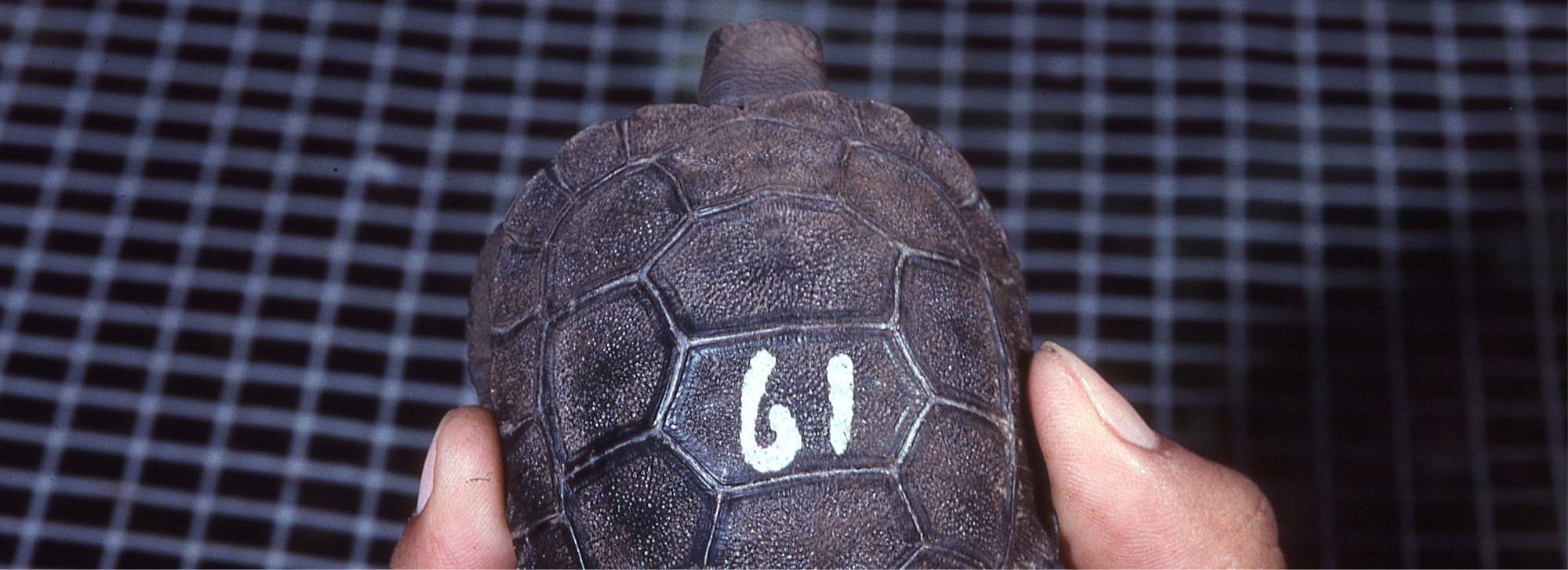Rearing tortoises
The presence of the iconic giant tortoises in Galapagos was already mentioned in the first text produced about the islands: Bishop Tomás de Berlanga’s letter to Spanish king Charles I. The archipelago was named after the reptiles, using an old Castilian word for "turtles", and since then they have appeared in almost all the books, chronicles, papers, news, and diaries related to the archipelago.
The initial relationship between humans and tortoises was a hunter-prey one: the animals fed the crews of the countless ships that landed in the Galapagos’ coasts since the 16th century onwards. In time, however, they were considered more of a "natural resource": besides being used by ships as storage food, they were captured by merchants as a source of oil and fuel, and therefore, as a trade good. From mid-19th century until 1959, naturalists and zoologists added their actions to the threats list: they hunted tortoises to enrich their collections, eventually bringing the animals to the brink of extinction.
With the development of strong protection measures for the Galapagoan biodiversity (starting with the creation of the National Park in 1959), the awareness about the urgent need to protect the tortoises raised, and eventually turn into practical, concrete actions.
According to Jacob Lundh’s Galapagos: A brief history (which, in terms of CDF’s history, is strongly based in the Noticias de Galápagos journals), tortoise marking begun in Santa Cruz under Raymond Lévêque, the first director of the Charles Darwin Research Station (CDRS), between 1960 and 1962. His successor in the position, André Brosset, continued those activities. As early as 1962, Dr. Herndon Dowling, curator of reptiles at the New York Zoological Park, collected tortoises on the islands for captive breeding. Also, a new and better system for marking tortoises was introduced by Prof. C. C. Carpenter: a combination of notches cut in the edges of the shells.
In 1963 David Snow started working as the CDRS director and expanded the survey of chelonians to other islands beyond Santa Cruz. Snow's report on Galapagoan tortoises (1964) included good news about the San Cristobal species reproducing in the late 1950's, and about those still surviving in Española.
Before 1970 it was found that 10 of the original 15 species of native tortoises survived, although they were seriously threatened by invasive predators. In 1965, Roger Perry, the new CDRS director, made an experiment: he brought eggs from Pinzón, where a small surviving population of tortoises had been trying to reproduce without success because of introduced rats. Although nothing was known about how to hatch eggs and raise young tortoises, Perry, Miguel Castro (CDRS conservation officer) and Anders Rambech (an early Norwegian settler in Puerto Ayora) made it work. This encouraged Perry to extend the program to other endangered species.
In May 1969, Rolf Sievers, the station manager, designed and built a house for the incubation and rearing of the tortoises, with financial support of the San Diego Zoological Society. It was inaugurated in 1970. Towards the end of that year, the first 20 tortoises hatched from Pinzón's eggs were released in their original island; two years later, 52 more followed.
All those processes were encouraged and supported by directors Peter Kramer (1970-1973) and Craig MacFarland, who arrived after Kramer. MacFarland had studied tortoises' populations and written several papers on how to protect them. Under his direction, the breeding program was strengthened and improved.
In 1975, the oldest of the Santiago and Española tortoises raised at the CDRS were taken to their islands. Also, San Cristobal tortoises were doing well, after local people reduced the number of wild dogs. Curiously enough, the production of tortoises at Santa Cruz reserve, located up in the island’s highlands, was damaged by dogs in 1971-1975.
By 1985, a further advancement was added to the breeding program: with advice from CDF-based scientists Howard and Heidi Snell, the CDRS and the Galapagos National Park hatched tortoises at different temperature and humidity levels, realizing that such traits determined the sex of the animals. This discovery led to the production of a greater proportion of females, fostering the results of the reproduction program.
By 1988, more than a thousand tortoises had been released. In Española only, there were more than 200 captive-bred animals.
Merlen, Godfrey. [Tortoise in breeding center]. [Slide]. [N.d.] : Godfrey Merlen, [ca1980]. [N.d.] : col. ill. : 3 x 5 cm. DDC 508. Well preserved.
Subject categories: Conservation | Herpetology | History of CDF | History of Galapagos | History of science
Keywords: Reptiles | Slides | Tortoises
Time framework: 1980
Text & picture: Edgardo Civallero (edgardo.civallero@fcdarwin.org.ec).
Publication date: 1 May 2022
Last update: 1 May 2022
